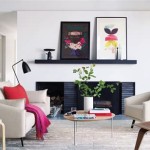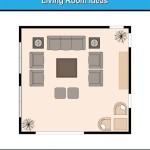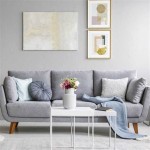Minimalist Living Room Decor Ideas: Achieving Serenity and Functionality
The minimalist lifestyle, characterized by intentionality and simplicity, has gained considerable traction in recent years. This philosophy extends beyond just decluttering; it’s about creating a space that fosters tranquility, promotes mental clarity, and prioritizes functionality over excess. A minimalist living room, therefore, becomes a sanctuary – a haven free from visual noise and unnecessary distractions.
The primary goal of minimalist living room décor is to reduce the amount of possessions on display and to select each item with purpose and intention. This doesn't mean the space has to be sterile or devoid of personality. Instead, it encourages a curated selection of items that are both aesthetically pleasing and practically useful. Focusing on quality over quantity is key to achieving a harmonious and balanced environment.
Before embarking on a minimalist living room transformation, a thorough assessment of existing belongings is essential. This process involves identifying items that are superfluous, redundant, or no longer serve a purpose. Decluttering is not merely about removing clutter; it's about making conscious decisions about what deserves a place in the living room and what needs to be donated, sold, or discarded.
The color palette for a minimalist living room typically revolves around neutral tones such as whites, creams, grays, and beiges. These colors create a sense of spaciousness, airiness, and calm. Accent colors can be incorporated sparingly through textiles, artwork, or plants to add a touch of visual interest without overwhelming the overall minimalist aesthetic. Consider incorporating natural materials like wood, stone, and linen to add warmth and texture to the space.
Furniture selection is a crucial aspect of minimalist living room décor. Opt for pieces that are simple in design, functional, and durable. Multi-functional furniture, such as a sofa bed or a coffee table with storage, can help maximize space and minimize clutter. When choosing furniture, prioritize clean lines, geometric shapes, and neutral colors. Avoid ornate details or overly decorative elements that can detract from the minimalist aesthetic.
Lighting plays a significant role in creating a welcoming and comfortable minimalist living room. Maximize natural light by keeping windows unobstructed and using sheer curtains or blinds. Supplement natural light with artificial lighting, such as floor lamps, table lamps, and recessed lighting. Choose lighting fixtures that are simple and understated in design. Avoid overly elaborate chandeliers or pendant lights that can disrupt the clean lines of the space.
Key Point 1: Prioritizing Functionality and Purpose
A core principle of minimalist design is the emphasis on functionality. Every item in the living room should serve a specific purpose and contribute to the overall usability of the space. Before introducing any new element, consider its practical value and whether it truly enhances the functionality of the room. Decorative items should be chosen carefully and contribute to the overall aesthetic without compromising the minimalist philosophy.
Consider the flow of the room. How do you move through the space? Ensure furniture placement facilitates easy movement and avoids creating unnecessary obstacles. Focus on creating a comfortable and inviting space that is conducive to relaxation and conversation. Avoid overcrowding the room with excessive furniture or décor. Leave ample open space to allow for freedom of movement and a sense of airiness.
Storage solutions are essential for maintaining a clutter-free minimalist living room. Incorporate storage cabinets, shelves, and baskets to keep belongings organized and out of sight. Choose storage solutions that are simple in design and blend seamlessly with the overall aesthetic of the room. Consider using closed storage options, such as cabinets with doors or drawers, to conceal items and maintain a clean and uncluttered look.
Wall décor in a minimalist living room should be carefully curated and kept to a minimum. Opt for a few statement pieces, such as a large-scale artwork or a collection of framed photographs, rather than a cluttered gallery wall. Choose artwork that is simple, abstract, or nature-inspired. Consider incorporating mirrors to reflect light and create a sense of spaciousness. Avoid overly ornate frames or decorative elements that can detract from the minimalist aesthetic.
Key Point 2: Embracing Neutral Color Palettes and Natural Materials
The color palette is a foundation of minimalist design. Sticking to neutral tones allows for a sense of calm and openness, which contributes significantly to the overall minimalist aesthetic. Whites, creams, grays, and beiges are commonly used as the base colors for walls, furniture, and textiles. These neutral colors create a blank canvas that can be accented with pops of color through accessories or plants.
Introducing natural materials, such as wood, stone, linen, and cotton, is crucial for adding warmth and texture to a minimalist living room. These materials create a sense of connection to nature and add a touch of organic beauty to the space. Consider using wooden furniture, stone accents, linen curtains, and cotton throws to incorporate natural materials into the décor. Avoid synthetic materials that can feel cold and sterile.
Textiles play a significant role in adding comfort and texture to a minimalist living room. Choose fabrics that are soft, natural, and durable. Linen, cotton, wool, and silk are excellent choices for upholstery, curtains, and throws. Opt for solid colors or subtle patterns to maintain the minimalist aesthetic. Consider incorporating textures such as knit, weave, and boucle to add visual interest without overwhelming the space.
Plants are a simple yet effective way to add life and vibrancy to a minimalist living room. Choose plants that are easy to care for and can thrive in the available light conditions. Consider using potted plants, hanging plants, or succulents to add a touch of greenery to the room. Arrange plants strategically to create focal points and add visual interest. Avoid using overly ornate planters or decorative elements that can detract from the minimalist aesthetic.
Key Point 3: Implementing Strategic Lighting Solutions and Decluttering Habits
Lighting is a critical element in creating a welcoming and functional minimalist living room. Strategically placed lighting can enhance the ambiance of the room, highlight architectural features, and provide adequate illumination for various activities. Maximize natural light by keeping windows unobstructed and using sheer curtains or blinds. Supplement natural light with artificial lighting, such as floor lamps, table lamps, and recessed lighting.
Choose lighting fixtures that are simple and understated in design. Avoid overly elaborate chandeliers or pendant lights that can disrupt the clean lines of the space. Opt for fixtures with clean lines, geometric shapes, and neutral colors. Consider using dimmers to adjust the brightness of the lights and create a more relaxed atmosphere. Task lighting, such as a floor lamp next to a reading chair, can provide focused illumination for specific activities.
Maintaining a minimalist living room requires consistent decluttering habits. Regularly assess belongings and remove items that are no longer needed or used. Develop a system for organizing and storing items to prevent clutter from accumulating. Make a habit of putting things away immediately after use. Consider donating, selling, or discarding items that are no longer needed or wanted.
By embracing intentionality and simplicity, a minimalist living room can transform into a serene and functional space that promotes well-being and productivity. The key is to prioritize quality over quantity, choose items with purpose, and maintain consistent decluttering habits. The result is a living room that is not only aesthetically pleasing but also conducive to relaxation, focus, and a more mindful way of life. Further enhancements might include integrated smart home technology, such as automated lighting controls or a sleek sound system, always ensuring these additions blend seamlessly into the minimalist design.
Consider rotating décor seasonally. Storing items that are not in use reduces visible clutter and keeps the space feeling fresh. This allows for a more intentional approach to decorating, preventing the accumulation of unnecessary items. Each piece should be appreciated for its functionality and aesthetic contribution to the space.
The benefits of a minimalist living room extend beyond aesthetics. Reducing visual clutter can decrease stress levels, improve focus, and promote a sense of calm. A minimalist environment can also encourage a more mindful lifestyle, prompting individuals to appreciate the things they have and to consume more consciously. It's about creating a space that reflects personal values and priorities, fostering a greater sense of well-being.

30 Minimalist Living Room Ideas

30 Minimalist Living Room Ideas

17 Minimalist Living Room Design Ideas Extra Space Storage

15 Minimalist Living Room Ideas That Prove Less Is More Hgtv

Minimalistic Living Room Design Ideas

34 Modern Minimalist Living Rooms Designer Examples Tips

Minimalistic Living Room Interior Design Decor Ideas Berger Blog

9 Ways To Minimalist Decor That Will Make Your Home Clutter Free

30 Minimalist Living Room Ideas

20 Cozy Minimalist Living Room Decor Ideas Shannon Torrens








